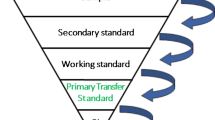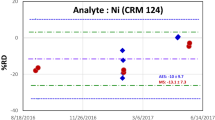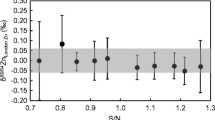Abstract
A high accuracy measurement procedure developed and validated at the Laboratory of the Government Chemist (LGC) has been transferred to a number of expert United Kingdom laboratories and their experience in applying the technique has been evaluated by inter-laboratory comparisons. It is an “approximate matching” calibration procedure for analysis of trace metals using isotope dilution mass spectrometry (IDMS). Use of a calibration blend and a sample blend having closely matched isotope amount ratios reduces systematic errors. Four comparisons were carried out, each evaluating an increasingly difficult aspect of the methodology. The final study required determination of trace levels of cadmium in an artificial food matrix acid digest containing tin, using both external calibration and approximate matching IDMS. The results of the trials clearly showed the superior accuracy of the IDMS approximate matching procedure; a result within 1% of the target reference value could be achieved. These trials and a training workshop enabled LGC to transfer its methodology to other expert laboratories, helping to improve the United Kingdom delivery of traceable reference measurements.









Similar content being viewed by others
References
Fassett J D, Paulsen PJ (1989) Anal Chem 61(10):643A
Henrion A (1994) Fresenius J Anal Chem 350:657
Catterick T, Fairman B, Harrington C (1998) J Anal At Spectrom 13:1009
Sargent M, Harrington C, Harte R (2002) Guidelines for achieving high accuracy in isotope dilution mass spectrometry (IDMS). Royal Society of Chemistry (RSC), Cambridge, UK: ISBN-85404–418–3
Watters, Jr RL, Eberhardt KR, Beary ES Fassett JD (1997) Metrologia 34: 87
Murphy KE, Beary ES, Rearick MS, Vocke RD (2000) Fresenius J Anal Chem 368:362
Webb KS, Carter D (1998) Metrologia 35:783
Webb KS, Carter D, Barwick VJ (1999) Metrologia 36:89
Dube G, Henrion A, Ohlendorf R (1999) Rapid Commun Mass Spectrom 13(12):1186
Wolff Briche SJ, Hernández H, O’Connor G, Webb KS, Catterick T (2000) Analyst 125:2189
Wolff Briche SJ, Carter D, Webb KS (2002) Rapid Commun Mass Spectrom 16:848
Milton MJT, Wielgosz RI (2000) Metrologia 37:199
Hoelzl R, Hoelzl C, Kotz L, Fabry L (1998) Accred Qual Assur 3(5):185
Ellison S, Williams A (1996) In: Parkany M (ed) The use of recovery factors in trace analysis. RSC, Cambridge, UK
Thompson M, Ellison S, Fajgelj A, Willetts P, Wood R (1999) J Pure Appl Chem 71(2):337
NIST:http://www.nist.gov/
Catterick T, Craston D, King B, Walker RF, Webb KS (1999) Accred Qual Assur 4:3
Acknowledgements
The work described in this paper forms part of the DTI Valid Analytical Measurement (VAM) Programme. Thanks are due to Ben Fairman and Tim Catterick at LGC for designing, organising and evaluating the inter-laboratory trials which were undertaken with the co-operation of the Royal Society of Chemistry’s Analytical Methods Committee (AMC), Sub-Committee on High Accuracy Analysis by Mass Spectrometry (HAAMS). The constitution of the Sub-Committee at the time was Dr G. Newman (Chairman), Dr P. Ash, Dr D. Blundell, Dr J. Carter, Dr T. Catterick, Dr J. Crighton, Dr M. Cullen, Dr T. Delves, Dr H. Evans, Dr B. Fairman, Dr P. Gardiner, S. Gardner, Dr H. Handley, Dr C. Hamlett, Miss R. Harte (Secretary), Dr S. Hird, Dr E. Houghton, Dr N. Hudson, Dr J. Lewis, Dr A. Midwood, Prof. J. Monaghan, Dr J. Morton, Dr G. O’Connor, Dr M. Patriarca, Dr C. Pickford, Dr M. Sargent, Ms C. Sieniawska, Dr J. Startin, Dr J. Truscott, Dr K. Webb, Dr M. White, Mr J. Wilson, Dr C. Wolff Briche and Mr D. Wood. The laboratories which participated in the trials are thanked for their time and effort: AEA Technologies, BP Chemicals, Central Science Laboratory (MAFF), Health and Safety Laboratory (HSL), Johnson Matthey, LGC(NW), Macaulay Land Use Research Institute, South East Water Ltd., the University of Plymouth and the University of Southampton.
Author information
Authors and Affiliations
Corresponding author
Rights and permissions
About this article
Cite this article
Harte, R., Newman, G. & Sargent, M. Achieving traceable chemical measurements: inter-laboratory evaluation of a simplified technique for isotope dilution mass spectrometry (IDMS). Part 1: Methodology for high accuracy analysis of trace metals. Accred Qual Assur 9, 33–38 (2004). https://doi.org/10.1007/s00769-003-0719-4
Received:
Accepted:
Published:
Issue Date:
DOI: https://doi.org/10.1007/s00769-003-0719-4




